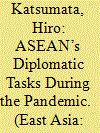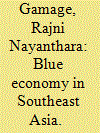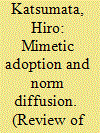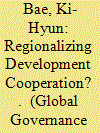|
|
|
Sort Order |
|
|
|
Items / Page
|
|
|
|
|
|
|
| Srl | Item |
| 1 |
ID:
186600


|
|
|
|
|
| Summary/Abstract |
What are the implications of COVID-19 for the diplomacy of the Association of Southeast Asian Nations (ASEAN)? What kinds of diplomatic tasks has the pandemic imposed on ASEAN, and in what way has the Southeast Asian association handled them? ASEAN’s most fundamental diplomatic task has of course been to continue building ASEAN communities, but the ability of the association of minor powers in Southeast Asia is limited. Hence, it can be said that ASEAN’s most important diplomatic task has been to maintain favorable relations with external powers, in particular, with China and the United States. The present study argues that ASEAN has managed to maintain favorable relations with and receive support from both of these external powers by conducting “equidistant diplomacy” with them. In concrete terms, it has fostered favorable relations with China. Yet, without relying excessively on Beijing, it made sure to foster such relations with the United States as well, thereby striking a reasonable balance between these two external powers.
|
|
|
|
|
|
|
|
|
|
|
|
|
|
|
|
| 2 |
ID:
150586


|
|
|
|
|
| Summary/Abstract |
While the term “blue economy” has found increasing traction with a variety of stakeholders (both state and non-state) in the recent past, a working definition of the concept at a regional or global level is yet to be arrived at. This paper begins with a brief examination of the concept of blue economy, followed by a discussion of blue economy initiatives undertaken or aspired towards at the regional level of Southeast Asia. In doing so, three fundamental propositions are made: First, the prospects for blue economy in Southeast Asia remain optimistic despite difficulties in collective action posed by the “ASEAN Way”, an obstacle which appears to have been considerably overcome in the launching of the ASEAN Economic Community (AEC) in 2015. Second, Indonesia’s growing economic and political profile allows it to assert the reins of regional (and even global) leadership on blue economy, without necessarily limiting itself to the Association of Southeast Asian Nations' (ASEAN) means and mechanisms. Third, while traditional security issues, both between Southeast Asian and extra-regional powers and within Southeast Asia over outstanding sovereignty and jurisdictional disputes, may impede cooperation on tackling non-traditional (maritime) security issues in the region, they may not prove as formidable an impediment against the successful realisation of blue economy initiatives.
|
|
|
|
|
|
|
|
|
|
|
|
|
|
|
|
| 3 |
ID:
112867


|
|
|
|
|
| Publication |
2012.
|
| Summary/Abstract |
Structural change brought about by the end of the Cold War and accelerated globalisation have transformed the global environment. A global governance complex is emerging, characterised by an ever-greater functional and regulatory role for multilateral organisations such as the United Nations (UN) and its associated agencies. The evolving global governance framework has created opportunities for regional organisations to participate as actors within the UN (and other multilateral institutions). This article compares the European Union (EU) and Association of Southeast Asian Nations (ASEAN) as actors within the UN network. It begins by extrapolating framework conditions for the emergence of EU and ASEAN actorness from the literature. The core argument of this article is that EU and ASEAN actorness is evolving in two succinct stages: Changes in the global environment create opportunities for the participation of regional organisations in global governance institutions, exposing representation and cohesion problems at the regional level. In response, ASEAN and the EU have initiated processes of institutional adaptation.
|
|
|
|
|
|
|
|
|
|
|
|
|
|
|
|
| 4 |
ID:
065864


|
|
|
|
|
| Publication |
London, Routledge, 2006.
|
| Description |
xix, 364p.
|
| Series |
Routledge advances in international relations and global politics
|
| Standard Number |
0415360579
|
|
|
|
|
|
|
|
|
|
|
|
Copies: C:1/I:0,R:0,Q:0
Circulation
| Accession# | Call# | Current Location | Status | Policy | Location |
| 050158 | 327.1/HAN 050158 | Main | On Shelf | General | |
|
|
|
|
| 5 |
ID:
102428


|
|
|
|
|
| Publication |
2011.
|
| Summary/Abstract |
The members of the Association of Southeast Asian Nations (ASEAN) have been pursuing new cooperative security agendas - namely, confidence-building measures (CBMs), preventive diplomacy (PD), conflict resolution and a set of agendas associated with security communities. The ASEAN members' pursuit of these agendas should be seen as a set of instances of their mimetic adoption of external norms for the sake of legitimacy. They have mimetically been adopting a set of norms associated with the collective management of conflicts, which have been practiced by the participant states of the Organisation for Security and Cooperation in Europe (OSCE). They have been doing so, with the intention of securing their identities as legitimate members of the community of modern states, and of enhancing the status of ASEAN and the ASEAN Regional Forum (ARF) as legitimate cooperative security institutions.
|
|
|
|
|
|
|
|
|
|
|
|
|
|
|
|
| 6 |
ID:
184096


|
|
|
|
|
| Summary/Abstract |
This article investigates Association of Southeast Asian Nations (ASEAN)-level development cooperation, a relatively overlooked dimension in assessing regionalism in Southeast Asia, by examining the Initiative for ASEAN Integration (IAI). The IAI provides a unique case of experimenting with multilateral South-South development cooperation based on regional solidarity; however, despite the declared aspirations and commitments to the program, this article finds that the IAI’s actual development has been quite contrary to the declared goals. First, unlike what was expected, IAI has not been able to provide institutional benefits to help pool ASEAN-6’s resources regionally and coordinate their development programs. Second, the principle of solidarity made the IAI valuable, but it did not stand out in its actions. Third, although its primary goal was to narrow the gap among members, IAI ironically created unwanted diplomatic divide and discontent. The observations confirm a perspective that constructing ASEAN as a regional community is both driven and constrained by member states’ nationalistic priorities.
|
|
|
|
|
|
|
|
|
|
|
|
|
|
|
|
| 7 |
ID:
110192


|
|
|
|
|
| Publication |
2012.
|
| Summary/Abstract |
At the 2005 World Summit, ASEAN Member States contributed to an official global consensus that states do indeed have a responsibility to protect their populations from the four mass atrocity crimes of genocide, ethnic cleansing, war crimes, and crimes against humanity. As is the case in a number of regions, however, there is a strong sense of caution - if not hostility - in Southeast Asia (and East Asia more broadly) towards the Responsibility to Protect's provision for military interventions as a last resort, in order to protect populations from such harm. Furthermore, there is an accompanying, more general ambivalence towards the perceived relevance of the norm for Southeast Asia, due to the perceived nature and/or intensity of conflicts in the region. Against this backdrop, this article attempts to shed light on a sub-altern discourse in the region that argues that the RtoP is not only relevant, but that it is critical it be operationalised in light of the various manifestations of conflict that plague the region.
|
|
|
|
|
|
|
|
|
|
|
|
|
|
|
|
| 8 |
ID:
167231


|
|
|
|
|
| Summary/Abstract |
This essay examines how the history of the Cold War in Southeast Asia has shaped, and will likely continue to shape, the current Sino-US rivalry in the region. Expert commentary today typically focuses on the agendas and actions of the two big powers, the United States and China, which actually risks missing the bigger picture. During the Cold War, leaders of ASEAN (Association of Southeast Asian Nations) played a critical role in containing Chinese influence, shaping the terms of Sino-US competition and rapprochement, and deepening the US presence in Southeast Asia. The legacy of ASEAN’s foreign relations during and since the Cold War imposes constraints on Chinese regional ambitions today, which militates against the popular notion that Chinese hegemony in East and Southeast Asia is inevitable. This essay underscores that current analyses of the brewing crisis in and around the South China Sea must routinely look beyond the two superpowers to the under-appreciated agency of small- and middle-sized ASEAN actors who, in reality, are the ones who hold the fate of the region in their hands.
|
|
|
|
|
|
|
|
|
|
|
|
|
|
|
|
| 9 |
ID:
116555


|
|
|
|
|
| Publication |
2012.
|
| Summary/Abstract |
The Treaty of Amity and Cooperation (TAC) is a foundational treaty by the Association of Southeast Asian Nations (ASEAN) to establish a code of conduct to govern inter-State relations in Southeast Asia. ASEAN has actively encouraged non-ASEAN States outside Southeast Asia to endorse this code of conduct by acceding to the TAC. This article examines the nature of accession by two non-ASEAN States, Australia and the USA, particularly their interpretative positions in relation to the TAC provisions on the prohibition against non-forcible intervention. It underlines the differences in which ASEAN, Australia and the USA understand the TAC's obligations. Whereas ASEAN has developed the TAC as a regional code of conduct inter se, Australia and the USA have been disinclined to accept the regional code of conduct and have made forceful attempts in their accession materials to influence the core meaning of the prohibition against non-forcible intervention.
|
|
|
|
|
|
|
|
|
|
|
|
|
|
|
|
|
|
|
|
|